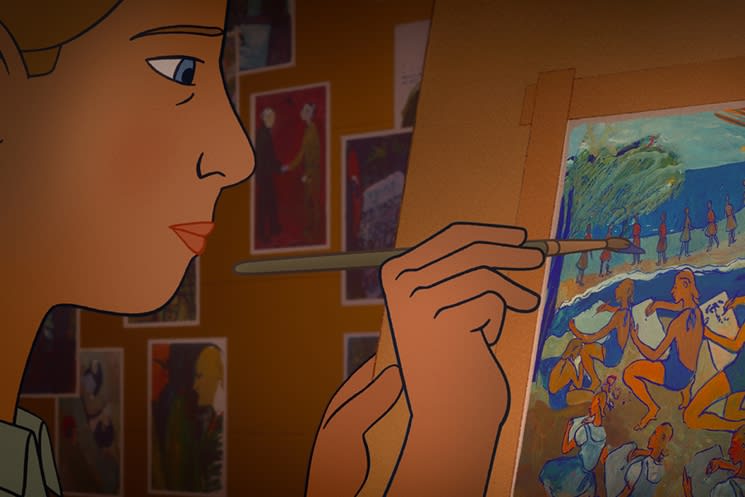What many consider the first comic strip was an autobiographical series of paintings titled "Life? Or Theater?: A Song-Play." This series consisted of 769 fantastical works painted during WWII by German-Jewish artist Charlotte Salomon. Directors Tahir Rana and Éric Warin, along with writers Erik Rutherford and David Bezmozgis, bring her and her work back to life in Charlotte. Not shying away from the horrors and violence experienced under Hitler's antisemitic regime, the film is both a tragic and beautiful story about life, death and the art in between.
The film begins at its end, with Charlotte (Keira Knightley doing emotional, soft voice work) entrusting her art to a friend, Dr. Moridis (Henry Czerny). It's a confusing way to begin the film for those unfamiliar with Charlotte, but it quickly jumps to backstory. She comes from a prosperous family in Berlin, living with her opera singer step-mother Paula (Helen McCrory) and surgeon father Albert (Eddie Marsan). Her passion for art starts at a young age and only grows when she is accepted into art school, despite being Jewish — her dream of becoming an artist within her grasp. She falls in love for the first time, too, with Alfred Wolfsohn (Mark Strong). He asks her to illustrate his stories of WWI, and in doing so, she unknowingly illustrates her own future. As the Nazi flag rises and war is declared, Charlotte is sent to live in the south of France with her grandparents. She falls in love again, this time with Alexander (Sam Claflin), but as the Germans close in, she's not sure how much time she has left. She decides to paint her own story.
Charlotte drags at times and the animation may be simpler than the big studios, but what makes it special are the drips and strokes of watercolours that fill the screen. Charlotte's work is brought to life before our eyes as though being painted for the first time. All of her emotions and heartbreak are felt through her work, and it all helps her cope with not only war but also a demon that has plagued her family for generations: mental illness. For all the shocking moments of tragedy, the film reminds us that "the world is bigger than Germany" — the world is bigger than hate.
(Elevation Pictures)The film begins at its end, with Charlotte (Keira Knightley doing emotional, soft voice work) entrusting her art to a friend, Dr. Moridis (Henry Czerny). It's a confusing way to begin the film for those unfamiliar with Charlotte, but it quickly jumps to backstory. She comes from a prosperous family in Berlin, living with her opera singer step-mother Paula (Helen McCrory) and surgeon father Albert (Eddie Marsan). Her passion for art starts at a young age and only grows when she is accepted into art school, despite being Jewish — her dream of becoming an artist within her grasp. She falls in love for the first time, too, with Alfred Wolfsohn (Mark Strong). He asks her to illustrate his stories of WWI, and in doing so, she unknowingly illustrates her own future. As the Nazi flag rises and war is declared, Charlotte is sent to live in the south of France with her grandparents. She falls in love again, this time with Alexander (Sam Claflin), but as the Germans close in, she's not sure how much time she has left. She decides to paint her own story.
Charlotte drags at times and the animation may be simpler than the big studios, but what makes it special are the drips and strokes of watercolours that fill the screen. Charlotte's work is brought to life before our eyes as though being painted for the first time. All of her emotions and heartbreak are felt through her work, and it all helps her cope with not only war but also a demon that has plagued her family for generations: mental illness. For all the shocking moments of tragedy, the film reminds us that "the world is bigger than Germany" — the world is bigger than hate.
